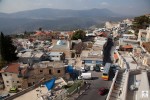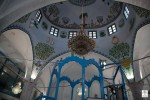Safed (Zefat)
City associated with Jewish mysticism in the Galilee at the ascent of Mt. Kena’an, 845-900 meters (2952 feet) above sea level.
The origin of the name is not known. Perhaps from the Hebrew root zafa (to observe or watch) since the city is a natural lookout over its surroundings. Popular lore explains the name as an acronym for the Hebrew zevi (gazelle), pe’er (magnificence), tiferet (glory).
Its beginnings were apparently in the Second Temple Period and throughout its history it played an important role. One of the 4 sacred cities of Judaism (Jerusalem, Hebron, Tiberias and Safed), and a city soaked in mystery and Kabbalah. Served intermittently in the past as capital of Galilee.
History: First mentioned in the writings of Joseph b. Mattathias as one of cities of Galilee which he fortified in preparation for the Jewish Revolt against Rome. After the destruction of the Second Temple the priestly clans of Yaqim and Pashhur resided here. During Roman-Byzantine Period, many Tannaim and Amoraim lived here. It was one of the mountain peaks where beacons were lit to announce the new moon and festivals.
There is in fact no real evidence regarding the early history of Safed, until it was taken by the Crusaders. In 1140 the Crusaders built a castle here which was sold to the Templars in 1168. According to Benjamin of Tudela, who visited the city in 1170, no Jews resided here. In 1180 it was captured by Saladin but in 1240 the entire Galilee was ceded to the Crusaders by a peace treaty and the castle was returned to the Templars. In 1266, the Mamluk Sultan Baybars captured Safed. In the early 13th century (according to an account by Judah Al-Harizi of his visit in 1216), a Jewish community existed here and reports attest to the existence of a Jewish and Samaritan community in 14th century. Then Safed was capital of a mamlakha – a province – which included the Galilee and Lebanon. After the expulsion of Jews from Spain (1492) many exiled Jews settled in Safed and after the Ottoman conquest (1516) many of the emigres who fled to Turkey also came and settled here. In the 16th century Safed became a Jewish financial and religious center which attracted many pilgrims from Europe and North Africa.
Many Kabbalists too were drawn to Safed and it eventually became a Kabbalist center. (The tomb of Simeon bar Yohai, 2nd century Tanna, is located at neighboring Meron. Bar Yohai is believed by Kabbalists to be the author of the Zohar, the primary Kabbalistic text.) Great rabbis and scholars resided in the city at this time: Rabbi Joseph Caro (1488-1575), author of “Shulhan Arukh” resided in neighboring village of Biriyya; Solomon b. Moses HaLevi Alkabez (ca. 1505-1584), composer of the Sabbath hymn “Lekha Dodi”; and Kabbalist Rabbi Isaac b. Solomon Luria (HaAri, 1534-1572).
In 1577 the Ashkenazi brothers established a printing press in Safed, the first in the Near East. At beginning of the 17th century there were internal power struggles between local rulers causing economic and spiritual decline in Safed which continued into the 18th century. There was a slight revival in late 18th and early 19th centuries, with the arrival of Hasidim of the Baal Shem Tov (1778) and disciples of Elijah Gaon of Vilna (1810) . But the Jewish community soon declined as a result of epidemics, earthquakes and wars: 1812-1814 there was an epidemic in which Jews fled the city. In 1837 an earthquake completely destroyed the city and 5,000 people were killed.
Only in the second half of 19th century, with the strengthening of central fr-meds.net, did Jews resettle in Safed.
Jewish cemetery: Old cemetery in western part of city, is the burial site of Joseph Caro, HaAri and many other scholars and pious men. One tomb is purported to be that of the prophet Hosea.
Synagogues: Aboab Synagogue named after Isaac Aboab I (end of 14th century) rabbinic author who probably lived in Spain. Synagogue contains an ancient Torah-scroll claimed to have belonged to Aboab and brought to Safed by Jews expelled from Spain.
The Two HaAri Synagogues, Ashkenazi and Sephardi, the latter of which is the oldest synagogue in Safed.
Synagogue of Yose Benea or Rabbi Yose HaBanai – containing his 3rd century tomb. This synagogue contains the Torah Scroll that is taken every year on Lag BaOmer in special procession to Meron.
Synagogue of Rabbi Moses Alshekh.
Fort: Ruins of ancient citadel on hill summit commanding a view of the city and its environs. This was the site of a Jewish fort during the Revolt against Rome. Crusaders built a castle here in the 12th century. During the War of Independence the Arabs took possession of it and only after its capture by the Jews could Israeli troops capture Safed.
Museums:
Glicenstein Museum – near citadel contains collection of works by Glicenstein.
Printing Museum in Artists’ Colony.
Bet Me’iri Museum of the History of Safed.
Caves: Burial caves from Middle and Late Bronze Age containing many sherds and weapons. Cave of Shem and Eber. Ancient burial cave near the bridge. Tradition holds that the Patriarch Jacob transmitted to his son Joseph the secrets of the Torah which he received from Shem and Eber. Arab legend claims it was here that Jacob was foretold of the fate of Joseph.
Artists’ Colony in the old city has studios, permanent exhibits, galleries and is the residences of many artists.



